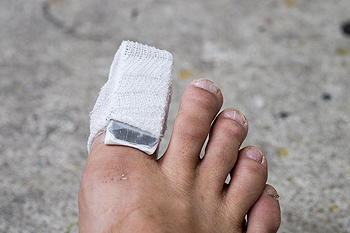Houston
Pearland
The forefoot is composed of five metatarsal bones and fourteen phalanges. Each toe has three phalanges except for the big toe which only has two. Our toes play an essential role to the walking process, which is why a broken toe could seriously disrupt one’s ability to move around. Toe fractures are common and can be very painful. Fortunately, these injuries rarely require surgery and usually heal with rest and a change in activity.
Broken toes typically result from a traumatic event such as falling, stubbing the toe, or dropping something on the toe. Traumatic toe fractures may be categorized as either minor or severe fractures. At times, one may hear a “pop” or “crack” sound when the bone breaks. Common symptoms of a traumatic toe fracture include pain, throbbing, bruising, swelling, and redness.
Another type of toe fractures is a stress fracture. These injuries usually appear in the form of small hairline breaks on the bone. Stress fractures develop after repetitive activity instead of a single injury. Stress fractures occur when the muscles in the bone become too weak to absorb impact. Consequently, the toe bone becomes vulnerable to any pressure and impact it endures. Symptoms for a stress fracture in the toe include swelling without bruising, tenderness to the touch, pain that goes away with rest, and pain after walking or running.
If you suspect that you have a broken toe, you should make an appointment with your podiatrist. He or she will likely diagnose you by performing a physical exam and an X-ray. Treatment for a broken toe may include the R.I.C.E. method, buddy taping, surgery, or antibiotics. The R.I.C.E. method (Rest, Ice, Compression, and Elevation) is a common treatment method for many injuries because it decreases pain. Buddy tapping involves wrapping the injured toe next to an adjacent toe to keep it supported and protected. These two methods have proven to be effective in the healing process for toe fractures. The estimated healing time for a broken toe is approximately four to six weeks. If the injury becomes infected or requires surgery, the estimated healing time may take eight weeks or more.
 Noticeable symptoms of a broken toe include severe pain, swelling, and bruising. In severe fractures, the bone may protrude from the skin, which can cause it to appear deformed. This ailment can occur if the toe suddenly hits a piece of furniture, or if a heavy object is dropped on it. Some patients can develop a broken toe as a result of a stress fracture. This is caused by repetitive movements or from wearing shoes that do not fit correctly. After a proper diagnosis takes place, which typically includes having an X-ray taken, the toe can be taped to the toe next to it. This is referred to as buddy taping. This procedure is helpful in maintaining stability as the healing process occurs. If you feel you have broken your toe, please consult with a podiatrist who can properly treat this condition.
Noticeable symptoms of a broken toe include severe pain, swelling, and bruising. In severe fractures, the bone may protrude from the skin, which can cause it to appear deformed. This ailment can occur if the toe suddenly hits a piece of furniture, or if a heavy object is dropped on it. Some patients can develop a broken toe as a result of a stress fracture. This is caused by repetitive movements or from wearing shoes that do not fit correctly. After a proper diagnosis takes place, which typically includes having an X-ray taken, the toe can be taped to the toe next to it. This is referred to as buddy taping. This procedure is helpful in maintaining stability as the healing process occurs. If you feel you have broken your toe, please consult with a podiatrist who can properly treat this condition.
A broken toe can be very painful and lead to complications if not properly fixed. If you have any concerns about your feet, contact Dr. Linda D. Nachmani from Central Foot & Ankle Associates. Our doctor will treat your foot and ankle needs.
What to Know About a Broken Toe
Although most people try to avoid foot trauma such as banging, stubbing, or dropping heavy objects on their feet, the unfortunate fact is that it is a common occurrence. Given the fact that toes are positioned in front of the feet, they typically sustain the brunt of such trauma. When trauma occurs to a toe, the result can be a painful break (fracture).
Symptoms of a Broken Toe
Generally, it is best to stay off of the injured toe with the affected foot elevated.
Severe toe fractures may be treated with a splint, cast, and in some cases, minor surgery. Due to its position and the pressure it endures with daily activity, future complications can occur if the big toe is not properly treated.
If you have any questions please feel free to contact one of our offices located in Houston, and Pearland, TX. We offer the newest diagnostic and treatment technologies for all your foot and ankle needs.
Read more about What to Know About a Broken Toe